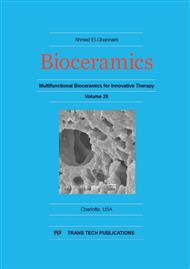[1]
J. D. B. Featherstone, Prevention and reversal of dental caries: role of low level fluoride, Community Dent Oral Epidemiol. 27 (1999) 31-40.
DOI: 10.1111/j.1600-0528.1999.tb01989.x
Google Scholar
[2]
J. M. ten Cate, J. D. B. Featherstone, Mechanistic aspects of the interactions between fluoride and dental enamel, Crit. Rev. Oral. Biol. 2 (1991) 283-296.
DOI: 10.1177/10454411910020030101
Google Scholar
[3]
J. D. B. Featherstone, R. Glena, M. Shariati, C. P. Shields, Dependence of in vitro demineralization and remineralization of dental enamel on fluoride concentration. J Dent Res. 69 (1990) 620-625.
DOI: 10.1177/00220345900690s121
Google Scholar
[4]
G. M. Whitford, G. S. Schuster, H. D. Pashley, Fluoride uptake by Streptococcus mutans 6715, Infect Immun. 18 (1977) 680-687.
DOI: 10.1128/iai.18.3.680-687.1977
Google Scholar
[5]
Maria Vallet-Regi, Francisco Balas, and Daniel Arcos, Mesoporous Materials for Drug Delivery, Angew. Chem. Int. Ed. 46 (2007) 7548-7558.
DOI: 10.1002/anie.200604488
Google Scholar
[6]
Hendrik Fullriede, Philipp Abendroth, Nina Ehlert, Katharina Doll, Jörn Schäske, Andreas Winkel, Sascha Nico Stumpp, Meike Stiesch and Peter Behrens, pH-responsive release of chlorhexidine from modified nanoporous silica nanoparticles for dental applications, BioNanoMat 17 (2016).
DOI: 10.1515/bnm-2016-0003
Google Scholar
[7]
Christian Argyo, Veronika Weiss, Christoph Bräuchle, Thomas Bein, Multifunctional Mesoporous Silica Nanoparticles as a Universal Platform for Drug Delivery, Chem. Mater. 26 (2014) 435−451.
DOI: 10.1021/cm402592t
Google Scholar
[8]
Qianjun He, Jianlin Shi, Mesoporous silica nanoparticle based nano drug delivery systems: synthesis, controlled drug release and delivery, pharmacokinetics and biocompatibility, J. Mater. Chem. 21 (2011) 5845-5855.
DOI: 10.1039/c0jm03851b
Google Scholar
[9]
Motohiro Tagaya, Toshiyuki Ikoma, Tomohiko Yoshioka, Satoshi Motozuka, Zhefeng Xu, Fujio Minami, Junzo Tanaka, Synthesis and luminescence properties of Eu(III)-doped nanoporous silica spheres, J Colloid Interface Sci. 363 (2011) 456-464.
DOI: 10.1016/j.jcis.2011.07.066
Google Scholar


